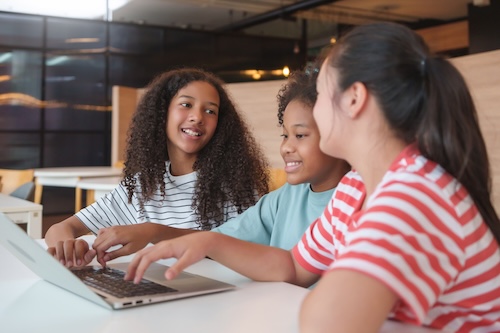- Discussion allows students to construct ideas, develop new knowledge and collaborative work, and is a tool for student motivation
- Discussion is integral because it helps students be successful
- Learning communities need to consciously honor students’ voices and experiences
In building opportunities for daily discussion in both physical and virtual learning spaces, educators can integrate technology to make space for collaborative interaction instead of focusing on traditional lectures.
A variety of multimodal tools can model using diverse technology to foster discussion:
HyperDocs: HypderDocs is a digital tool that uses hyperlinks to package a variety of learning materials in one space. Within the doc, students work collaboratively to complete a variety of learning tasks. The digital document is designed for student collaboration and small group discussion. This engages students and provides opportunities for students to explore. Using HyperDocs, the instructor explains concepts through a mini-lesson, students share their learning by elaborating on topics/objectives, and they evaluate their learning through reflection.
Padlet: Padlet is a digital tool that uses one single place as a virtual bulletin board, which can be public or private. The interactive space makes it easy to use and makes discussion, including virtual discussion, easily accessible from any web-enabled device. Students can create a bank of ideas to use for their final project. Because it’s a virtual space, students can discuss materials asynchronously if they can’t meet to discuss ideas face-to-face or synchronously.
Jigsaw: Using this peer-to-peer learning approach, students collaborate within groups to develop their expert understanding. Students can collaboratively create a video-recorded presentation for their assigned workshop mini-lesson. They then share their screencast via LMS, Padlet, or a similar tool for other groups to use as a reference. This strategy offers a great space for students to discuss and work together. It also helps build students’ confidence around the topics they’re learning about.
Inquiry Chart: This strategy helps students organize and analyze information from different sources to broaden their understanding of the topic. Students review the same current events across different outlets to evaluate tone and language, the central focus, how information is shared, and how the information/story is represented. Teachers can use Google Slides or another collaborative online tool that gives editing access to multiple people. Students generate research questions, or inquiry questions, and look across a variety of multimodal resources to find answers to their questions, pinpoint where resources align or don’t align, and discuss why the resources are saying different things.
Three Big Questions: Using this low-prep discussion strategy, students interact with a text and collect notes on the three big questions. After reading, students can share their responses via Padlet in text, image, and video. Students also can read and respond to other peers’ responses. The questions are: What surprised me? What did the author think I already knew? What challenged changed or confirmed what I knew?
Technology can enhance teachers’ current instructional practices in a variety of ways:
- Consider a current model or unit and its assessment: What is the content students need to know or understand? What do students need to be able to do?
- Determine what materials and resources you want students to engage with while learning: Are there multiple modalities or resources and materials possible for students to use?
- Collaboration/discussion is important to learning: Identify the opportunities for students to collaborate with one another.
- Student agency boosts achievement: Ensure there is choice built into the learning experience.

This post is exclusively published on eduexpertisehub.com
Source link

